Sports in Natural Forests: A Systematic Review of Environmental Impact and Compatibility for Readability
Abstract
1. Introduction
2. Materials and Methods
3. Results
3.1. Bibliometric Analyses
3.2. Literature Review
3.2.1. Sports and Urban Forests
The Relationship Between Green-Blue Spaces and Physical Exercise
Health Benefits of Exercising in Natural Outdoor Environments
Global Perspectives on Urban Forests and Sports
3.2.2. Sports Tourism and Natural Forests
3.2.3. Hunting and Fishing in Natural Forests
Wildlife Population Control and Ecosystem Management
Hunting and Conservation Efforts
Economic Contributions of Fishing in Natural Forests
3.2.4. Other Types of Sports in Natural Forests
3.2.5. Positive Effects of Sports in Natural Forests
3.2.6. Adverse Impacts of Sporting Activities on Natural Forests: Dissatisfaction and Conflicts
4. Discussion
4.1. Existing Literature on Sports and Natural Forests
4.2. Different Types of Sports Practiced in Natural Forests
4.3. Sports and Urban Forests
4.4. Positive and Negative Effects of Sports Practiced in Natural Forests
4.5. Limitations and Future Research
5. Conclusions
Author Contributions
Funding
Conflicts of Interest
References
- Brink, E.; Aalders, T.; Ádám, D.; Feller, R.; Henselek, Y.; Hoffmann, A.; Wamsler, C. Cascades of green: A review of ecosystem-based adaptation in urban areas. Glob. Environ. Change 2016, 36, 111–123. [Google Scholar] [CrossRef]
- Bratman, G.N.; Anderson, C.B.; Berman, M.G.; Cochran, B.; De Vries, S.; Flanders, J.; Daily, G.C. Nature and mental health: An ecosystem service perspective. Sci. Adv. 2019, 5, eaax0903. [Google Scholar] [CrossRef] [PubMed]
- Kahn, P.H., Jr.; Ruckert, J.H.; Severson, R.L.; Reichert, A.L.; Fowler, E. A nature language: An agenda to catalog, save, and recover patterns of human–nature interaction. Ecopsychology 2010, 2, 59–66. [Google Scholar] [CrossRef]
- Staats, H.; Van Gemerden, E.; Hartig, T. Preference for restorative situations: Interactive effects of attentional state, activity-in-environment, and social context. Leis. Sci. 2010, 32, 401–417. [Google Scholar] [CrossRef]
- Mocanu, G.D.; Murariu, G.; Munteanu, D. The Influence of Socio-Demographic Factors on the Forms of Leisure for the Students at the Faculty of Physical Education and Sports. Int. J. Environ. Res. Public Health 2021, 18, 12577. [Google Scholar] [CrossRef]
- Hartig, T.; Catalano, R.; Ong, M.; Syme, S.L. Vacation, collective restoration, and mental health in a population. Soc. Ment. Health 2013, 3, 221–236. [Google Scholar] [CrossRef]
- Korpela, K.; Borodulin, K.; Neuvonen, M.; Paronen, O.; Tyrväinen, L. Analyzing the mediators between nature-based outdoor recreation and emotional well-being. J. Environ. Psychol. 2014, 37, 1–7. [Google Scholar] [CrossRef]
- Oprică, R.; Tudose, N.C.; Davidescu, S.O.; Zup, M.; Marin, M.; Comanici, A.N.; Crit, M.N.; Pitar, D. Gender inequalities in Transylvania’s largest peri-urban forest usage. Ann. For. Res. 2022, 65, 57–69. [Google Scholar] [CrossRef]
- Fuster Matute, J.; Farias Torbidoni, E.I.; Gil, G.; Seguí Urbaneja, J. Analysis of the Poblet Forest Trekorientació®: A sustainable sports event in the natural environment. CABI Databases 2014, 115, 61–71. [Google Scholar]
- O’Brien, L.; Forster, J. Sustaining and changing sport and physical activity behaviours in the forest: An evaluated pilot intervention on five public forest sites in England. Urban For. Urban Green. 2020, 55, 126844. [Google Scholar] [CrossRef]
- Mocanu, G.D.; Murariu, G.; Georgescu, L.; Sandu, I. Investigating the Attitudes of First-Year Students of the Faculty of Physical Education and Sports of Galati towards Online Teaching Activities during the COVID-19 Pandemic. Appl. Sci. 2021, 11, 6328. [Google Scholar] [CrossRef]
- Kobayashi, H.; Ikei, H.; Song, C.; Kagawa, T.; Miyazaki, Y. Comparing the impact of forest walking and forest viewing on psychological states. Urban For. Urban Green. 2021, 57, 126920. [Google Scholar] [CrossRef]
- Hansmann, R.; Hug, S.M.; Seeland, K. Restoration and stress relief through physical activities in forests and parks. Urban For. Urban Green. 2007, 6, 213–225. [Google Scholar] [CrossRef]
- Kisusi, R.L.; Masele, J.J. Efficacy of public awareness strategies for promoting existing cultural heritage tourism assets in Dar es Salaam. J. Herit. Tour. 2018, 14, 117–137. [Google Scholar] [CrossRef]
- Vidal-González, P.; Vidal-Matzanke, A. The Mosquera Valley in Sierra de Espadán Natural Park, Spain, as a designed mountain landscape: Past and present uses. Geosciences 2020, 10, 159. [Google Scholar] [CrossRef]
- Cremades, R.; Sanchez-Plaza, A.; Hewitt, R.J.; Mitter, H.; Baggio, J.A.; Olazabal, M.; Broekman, A.; Kropf, B.; Tudose, N.C. Guiding cities under increased droughts: The limits to sustainable urban futures. Ecol. Econ. 2021, 189, 107140. [Google Scholar] [CrossRef]
- Tudose, N.C.; Cremades, R.; Broekman, A.; Sanchez-Plaza, A.; Mitter, H.; Marin, M. Mainstreaming the nexus approach in climate services will enable coherent local and regional climate policies. Adv. Clim. Chang. Res. 2021, 12, 752–755. [Google Scholar] [CrossRef]
- Tudose, N.C.; Cheval, S.; Ungurean, C.; Broekman, A.; Sanchez-Plaza, A.; Cremades, R.; Mitter, H.; Kropf, B.; Davidescu, Ș.O.; Dincă, L.; et al. Climate services for sustainable resource management: The water-energy-land nexus in the Tarlung river basin (Romania). Land Use Policy 2022, 119, 106221. [Google Scholar] [CrossRef]
- Tudose, N.C.; Marin, M.; Cheval, S.; Mitter, H.; Broekman, A.; Sanchez-Plaza, A.; Ungurean, C.; Davidescu, S. Challenges and opportunities of knowledge co-creation for the water-energy-land nexus. Clim. Serv. 2023, 30, 100340. [Google Scholar] [CrossRef]
- Lepillé, R. Forest: The ‘Other’ stadium? Digital transition and its effects on Rouen metropolis wooded areas. J. Alp. Res. 2024, 111, 1–18. [Google Scholar]
- Dai, L.; Li, S.; Zhou, W.; Qi, L.; Zhou, L.I.; Wei, Y.; Yu, D. Opportunities and challenges for the protection and ecological functions promotion of natural forests in China. For. Ecol. Manag. 2018, 410, 187–192. [Google Scholar] [CrossRef]
- European Commission. Forests in Sustainable Development; Annex 4.6, Glossary of Terms; European Commission: Brussels, Belgium, 1996. [Google Scholar]
- Peterken, G.F. Natural Woodland: Ecology and Conservation in Northern Temperate Regions; Cambridge University Press: Cambridge, UK, 1996. [Google Scholar]
- COST E4. Forest Reserves Research Network in Europe. Final Report. 2000. Available online: https://www.cost.eu/actions/E4/?utm_source=chatgpt.com (accessed on 3 June 2025).
- Buchwald, E. A hierarchical terminology for more or less natural forests in relation to sustainable management and biodiversity conservation. In Proceedings of the Third Expert Meeting on Harmonizing Forest-Related Definitions, Rome, Italy, 17–19 January 2005; pp. 17–19. [Google Scholar]
- Cao, T.; Han, D.; Song, X. Past, present, and future of global seawater intrusion research: A bibliometric analysis. J. Hydrol. 2021, 603, 126844. [Google Scholar] [CrossRef]
- Timis-Gansac, V.; Dinca, L.; Constandache, C.; Murariu, G.; Cheregi, G.; Timofte, C.S.C. Conservation biodiversity in arid areas: A review. Sustainability 2025, 17, 2422. [Google Scholar] [CrossRef]
- Dinca, L.; Murariu, G.; Lupoae, M. Understanding the Ecosystem Services of Riparian Forests: Patterns, Gaps, and Global Trends. Forests 2025, 16, 947. [Google Scholar] [CrossRef]
- Dinca, L.; Crisan, V.; Ienasoiu, G.; Murariu, G.; Drasovean, R. Environmental indicator plants in mountain forests: A review. Plants 2024, 13, 3358. [Google Scholar] [CrossRef]
- Biscaia, R.; Ramos, R.F.; Yoshida, M.; Kim, Y. Service quality in spectator sports: A review and research agenda. Int. J. Consum. Stud. 2024, 48, e13086. [Google Scholar] [CrossRef]
- Clancy, R.B.; Herring, M.P.; Campbell, M.J. Motivation measures in sport: A critical review and bibliometric analysis. Front. Psychol. 2017, 8, 348. [Google Scholar] [CrossRef] [PubMed]
- Hammerschmidt, J.; Calabuig, F.; Kraus, S.; Uhrich, S. Tracing the state of sport management research: A bibliometric analysis. Manag. Rev. Q 2024, 74, 1185–1208. [Google Scholar] [CrossRef]
- Pal Singh, G.; Chakraborty, A.; Arora, S.D. Uncovering the knowledge structure of the fan-sporting object relationship: A bibliometric analysis. Sport Manag. Rev. 2023, 26, 181–202. [Google Scholar] [CrossRef]
- Gonçalves, A.F.A.; Santos, J.A.D.; França, L.C.D.J.; Campoe, O.C.; Altoé, T.F.; Scolforo, J.R.S. Use of the process-based models in forest research: A bibliometric review. Cerne 2021, 27, e-102769. [Google Scholar] [CrossRef]
- Ma, Z.; Hu, C.; Huang, J.; Li, T.; Lei, J. Forests and forestry in support of sustainable development goals (SDGs): A bibliometric analysis. Forests 2022, 13, 1960. [Google Scholar] [CrossRef]
- Ordoñez-Díaz, M.C.; Galicia, L. Bibliometric analysis of models for temperate forest management: A global perspective on sustainable forest management tools. Rev. Chapingo Ser. Cienc. For. Ambient. 2020, 26, 357–372. [Google Scholar]
- Yardibi, F.; Kang, K.S.; Özbey, A.A.; Bilir, N. Bibliometric analysis of trends and future directions of research and development of seed orchards. Forests 2024, 15, 953. [Google Scholar] [CrossRef]
- Dinca, L.; Constandache, C.; Postolache, R.; Murariu, G.; Tupu, E. Timber harvesting in mountainous regions: A comprehensive review. Forests 2025, 16, 495. [Google Scholar] [CrossRef]
- Clarivate.com. Web of Science Core Collection. 2024. Available online: https://clarivate.com/products/scientific-and-academic-research/research-discovery-and-workflow-solutions/webofscience-platform/web-of-science-core-collection/ (accessed on 2 February 2025).
- Microsoft Corporation. Microsoft Excel. 2025. Available online: https://microsoft.com/en-us/microsoft-365/excel (accessed on 5 February 2025).
- Google Developers. Geochart. Developers. Available online: https://google.com/chart/interactive/docs/gallery/geochart (accessed on 10 February 2025).
- VOS Viewer. VOS Viewer. 2025. Available online: https://vosviewer.com (accessed on 8 February 2025).
- Page, M.J.; McKenzie, J.E.; Bossuyt, P.M.; Boutron, I.; Hoffmann, T.C.; Mulrow, C.D.; Shamseer, L.; Tetzlaff, J.M.; Akl, E.A.; Brennan, S.E.; et al. The PRISMA 2020 Statement: An Updated Guideline for Reporting Systematic Reviews. BMJ 2021, 372, n71. [Google Scholar] [CrossRef]
- Baumeister, C.F.; Gerstenberg, T.; Plieninger, T.; Schraml, U. Exploring cultural ecosystem service hotspots: Linking multiple urban forest features with public participation mapping data. Urban For. Urban Green. 2020, 48, 126561. [Google Scholar] [CrossRef]
- Tan, C.L.; Chang, C.C.; Nghiem, L.T.; Zhang, Y.; Oh, R.R.; Shanahan, D.F.; Carrasco, L.R. The right mix: Residential urban green-blue space combinations are correlated with physical exercise in a tropical city-state. Urban For. Urban Green. 2021, 57, 126947. [Google Scholar] [CrossRef]
- Karusisi, N.; Bean, K.; Oppert, J.M.; Pannier, B.; Chaix, B. Multiple dimensions of residential environments, neighborhood experiences, and jogging behavior in the RECORD Study. Prev. Med. 2012, 55, 50–55. [Google Scholar] [CrossRef]
- Lahart, I.; Darcy, P.; Gidlow, C.; Calogiuri, G. The effects of green exercise on physical and mental wellbeing: A systematic review. Int. J. Environ. Res. Public Health 2019, 16, 1352. [Google Scholar] [CrossRef]
- Rogerson, M.; Gladwell, V.F.; Gallagher, D.J.; Barton, J.L. Influences of green outdoors versus indoors environmental settings on psychological and social outcomes of controlled exercise. Int. J. Environ. Res. Public Health 2016, 13, 363. [Google Scholar] [CrossRef]
- Hagberg, L.A.; Lindahl, B.; Nyberg, L.; Hellénius, M.L. Importance of enjoyment when promoting physical exercise. Scand. J. Med. Sci. Sports 2009, 19, 740–747. [Google Scholar] [CrossRef]
- Schwaneberg, T.; Weymar, F.; Ulbricht, S.; Dörr, M.; Hoffmann, W.; van den Berg, N. Relationship between objectively measured intensity of physical activity and self-reported enjoyment of physical activity. Prev. Med. Rep. 2017, 7, 162–168. [Google Scholar] [CrossRef]
- Sugiyama, T.; Giles-Corti, B.; Summers, J.; du Toit, L.; Leslie, E.; Owen, N. Initiating and maintaining recreational walking: A longitudinal study on the influence of neighborhood green space. Prev. Med. 2013, 57, 178–182. [Google Scholar] [CrossRef]
- Martens, D.; Gutscher, H.; Bauer, N. Walking in “wild” and “tended” urban forests: The impact on psychological well-being. J. Environ. Psychol. 2011, 31, 36–44. [Google Scholar] [CrossRef]
- Yıldırım, H.T.; Yıldızbaş, N.T.; Uyar, Ç.; Elvan, O.D.; Sousa, H.F.P.E.; Dinis, M.A.P.; Perkumienė, D. Visitors’ perceptions towards the sustainable use of forest areas: The case of Istanbul Belgrade Nature Parks. Forests 2024, 15, 1687. [Google Scholar] [CrossRef]
- Chen, B.; Qi, X.; Qiu, Z. Recreational use of urban forest parks: A case study in Fuzhou National Forest Park, China. J. For. Res. 2018, 23, 183–189. [Google Scholar] [CrossRef]
- Chae, J.; Park, J.; Kim, S. Restorative environment characteristics of an urban forest based on big data analytics. Forests 2023, 14, 1770. [Google Scholar] [CrossRef]
- Doli, A.; Bamwesigye, D.; Hlaváčková, P.; Fialová, J.; Kupec, P.; Asamoah, O. Forest park visitors’ opinions and willingness to pay for sustainable development of the Germia Forest and Recreational Park. Sustainability 2021, 13, 3160. [Google Scholar] [CrossRef]
- Veitch, J.; Ball, K.; Crawford, D.; Abbott, G.R.; Salmon, J. Park improvements and park activity: A natural experiment. Am. J. Prev. Med. 2012, 42, 616–619. [Google Scholar] [CrossRef]
- Cohen, D.A.; Golinelli, D.; Williamson, S.; Sehgal, A.; Marsh, T.; McKenzie, T.L. Effects of park improvements on park use and physical activity: Policy and programming implications. Am. J. Prev. Med. 2009, 37, 475–480. [Google Scholar] [CrossRef]
- Chong, S.; Mazumdar, S.; Ding, D.; Morgan, G.; Comino, E.J.; Bauman, A.; Jalaludin, B. Neighbourhood greenspace and physical activity and sedentary behaviour among older adults with a recent diagnosis of type 2 diabetes: A prospective analysis. BMJ Open 2019, 9, e028947. [Google Scholar] [CrossRef]
- Qu, T. Sports tourism and tourism sports. J. Wuhan Inst. Phys. Educ. 2009, 43, 28–31. [Google Scholar]
- Shang, L.W. A study on the exploration of sports tourism resources in South Sichuan. In Future Computer, Communication, Control and Automation; Springer: Berlin/Heidelberg, Germany, 2012; pp. 241–248. [Google Scholar]
- Zhu, H. Correlation concepts of sports tourism resources and the development principle. J. Shandong Inst. Phys. Educ. Sports 2008, 24, 48–49. [Google Scholar]
- Mazurek-Kusiak, A.; Soroka, A. Motives and barriers to practice orienteering in the forest environment. Sylwan 2021, 165, 157–164. [Google Scholar]
- Oliveira, P.; Panagopoulos, T. Post-fire landscape rehabilitation at the protected area of Montejunto, Portugal. In New Aspects of Landscape Architecture; Panagopoulos, T., Burley, J., Eds.; WSEAS Press: Athens, Greece, 2008; pp. 157–161. [Google Scholar]
- He, Y.; Wu, L. Analysis on spatial development mode of eco-sports tourism in Grand Canal landscape environment culture belt. Environ. Monit. Assess. 2022, 194, 925. [Google Scholar] [CrossRef] [PubMed]
- Kropinova, E.G.; Anokhin, A.Y.; Primak, T.K. Ecotourism-a 21st century necessity or responding to consumer demand. Geoj. Tour. Geosites 2023, 46, 37–45. [Google Scholar] [CrossRef]
- Alam, R.; Nayak, D. Trends and patterns of ecotourism research: Practices and implications. Int. J. Tour. Policy 2020, 10, 351–379. [Google Scholar] [CrossRef]
- Newland, B.L.; Aicher, T.J.; Davies, M.; Hungenberg, E. Sport event ecotourism: Sustainability of trail racing events in US National Parks. J. Sport Tour. 2021, 25, 155–181. [Google Scholar] [CrossRef]
- Lebel, F.; Dussault, C.; Massé, A.; Côté, S.D. Influence of habitat features and hunter behavior on white-tailed deer harvest. J. Wildl. Manag. 2012, 76, 1431–1440. [Google Scholar] [CrossRef]
- Hothorn, T.; Müller, J. Large-scale reduction of ungulate browsing by managed sport hunting. For. Ecol. Manag. 2010, 260, 1416–1423. [Google Scholar] [CrossRef]
- Hörnberg, S. Changes in population density of moose (Alces alces) and damage to forests in Sweden. For. Ecol. Manag. 2001, 149, 141–151. [Google Scholar] [CrossRef]
- Hester, A.J.; Edenius, L.; Buttenschøn, R.M.; Kuiters, A.T. Interactions between forests and herbivores: The role of controlled grazing experiments. Forestry 2000, 73, 381–391. [Google Scholar] [CrossRef]
- Tremblay, J.P.; Hester, A.; McLeod, J.; Huot, J. Choice and development of decision support tools for the sustainable management of deer-forest systems. For. Ecol. Manag. 2004, 191, 1–16. [Google Scholar] [CrossRef]
- Simard, M.A.; Dussault, C.; Huot, J.; Côté, S.D. Is hunting an effective tool to control overabundant deer? A test using an experimental approach. J. Wildl. Manag. 2013, 77, 254–269. [Google Scholar] [CrossRef]
- Gallina, S. Is sustainability possible in protected areas in Mexico? Deer as an example of a renewable resource. Sustainability 2012, 4, 2366–2376. [Google Scholar] [CrossRef]
- Obbard, M.E.; Howe, E.J.; Wall, L.L.; Allison, B.; Black, R.; Davis, P.; Hall, M.N. Relationships among food availability, harvest, and human–bear conflict at landscape scales in Ontario, Canada. Ursus 2014, 25, 98–110. [Google Scholar] [CrossRef]
- Usongo, L.; Nkanje, B.T. Participatory approaches towards forest conservation: The case of Lobéké National Park, southeast Cameroon. Int. J. Sustain. Dev. World Ecol. 2004, 11, 119–127. [Google Scholar] [CrossRef]
- El Bizri, H.R.; Oliveira, M.A.; Rampini, A.P.; Knoop, S.; Fa, J.E.; Coad, L.; Bogoni, J.A. Exposing illegal hunting and wildlife depletion in the world’s largest tropical country through social media data. Conserv. Biol. 2024, 38, e14334. [Google Scholar] [CrossRef]
- Gillespie, N.; Epstein, J.; Alexander, S.; Bowker, J.M.; Medel, R.; Leonard, M.; Thoms, A. Socioeconomic benefits of recreational, commercial, and subsistence fishing associated with national forests. Fisheries 2018, 43, 432–439. [Google Scholar] [CrossRef]
- Hansmann, R.; Whitehead, I.; Krajter Ostoić, S.; Živojinović, I.; Stojanovska, M.; Jones, N.; Barstad, J. Partnerships for urban forestry and green infrastructure delivering services to people and the environment: A review on what they are and aim to achieve. South-East Eur. For. 2016, 7, 9–19. [Google Scholar]
- Pröbstl-Haider, U.; Hödl, C.; Ginner, K.; Borgwardt, F. Climate change: Impacts on outdoor activities in the summer and shoulder seasons. J. Outdoor Recreat. Tour. 2021, 34, 100344. [Google Scholar] [CrossRef]
- Konieczny, A.A.; Gołos, P.; Sikora, A.T. Threats to the forest ecosystem and visitors in forest areas in the opinion of tourists in the Krynki Forest District. Sylwan 2020, 164, 25–31. [Google Scholar]
- Jungwirth, D.; Weninger, C.A.; Haluza, D. Fitness and the crisis: Impacts of COVID-19 on active living and life satisfaction in Austria. Int. J. Environ. Res. Public Health 2021, 18, 13073. [Google Scholar] [CrossRef] [PubMed]
- Zhang, H.; Yu, J.; Dong, X.; Zhai, X.; Shen, J. Rethinking cultural ecosystem services in urban forest parks: An analysis of citizens’ physical activities based on social media data. Forests 2024, 15, 1633. [Google Scholar] [CrossRef]
- Koniak, G.; Sheffer, E.; Noy-Meir, I. Recreation as an ecosystem service in open landscapes in the Mediterranean region in Israel: Public preferences. Isr. J. Ecol. Evol. 2011, 57, 151–171. [Google Scholar] [CrossRef]
- King, K.; Church, A. Questioning policy, youth participation and lifestyle sports. Leis. Stud. 2015, 34, 282–302. [Google Scholar] [CrossRef]
- Queirós, M. Natural parks in Portugal: A way to become more ecologically responsible? Environ. Hist. 2012, 18, 585–611. [Google Scholar] [CrossRef]
- Omodei, M.M.; McLennan, J. Studying complex decision making in natural settings: Using a head-mounted video camera to study competitive orienteering. Percept. Mot. Ski. 1994, 79, 1411–1425. [Google Scholar] [CrossRef]
- Aydınözü, D.; İbret, Ü.; Aydın, M. Analysis of terrain usage in Kastamonu-Ilgaz Mountain Natural Park. Int. Symp. Environ. Prot. Plan. 2011, 132–137. [Google Scholar]
- Nabout, J.C.; Tessarolo, G.; Pinheiro, G.H.B.; Marquez, L.A.M.; de Carvalho, R.A. Unraveling the paths of water as aquatic cultural services for the ecotourism in Brazilian protected areas. Glob. Ecol. Conserv. 2022, 33, e01958. [Google Scholar] [CrossRef]
- Thompson, C.W.; Elizalde, A.; Cummins, S.; Leyland, A.H.; Botha, W.; Briggs, A.; Tilley, S.; de Oliveira, E.S.; Roe, J.; Aspinall, P.; et al. Enhancing health through access to nature: How effective are interventions in woodlands in deprived urban communities? A quasi-experimental study in Scotland, UK. Sustainability 2019, 11, 3317. [Google Scholar] [CrossRef] [PubMed]
- Mintz, K.K.; Ayalon, O.; Eshet, T.; Nathan, O. The influence of social context and activity on the emotional well-being of forest visitors: A field study. J. Environ. Psychol. 2024, 94, 102234. [Google Scholar] [CrossRef]
- Ýbret, Ü. Ilgaz’da kış turizmi. Türk Coğrafya Derg. 2003, 41, 121–132. [Google Scholar]
- Güleryüz, G.; Kirmizi, S.; Arslan, H.; Kondu Yakut, E. Alterations of the nitrogen mineralization rates in soils of forest community depending on the ski run construction (Mount Uludağ, Bursa, Turkey). J. Mt. Sci. 2011, 8, 53–61. [Google Scholar] [CrossRef]
- Derkacheva, A.; Golosov, V.; Shvarev, S. Hazardous exogenous geological processes in the mountains under the pressure of human activity: 15-year observations from a natural landscape to a large ski resort. Nat. Hazards 2024, 120, 2847–2868. [Google Scholar] [CrossRef]
- Mackenzie, D. Alpine countries seek controls on skiers, builders and roads. New Sci. 1989, 124, 22. [Google Scholar]
- Rixen, C.; Stoeckli, V.; Ammann, W. Does artificial snow production affect soil and vegetation of ski pistes? A review. Perspect. Plant Ecol. Evol. Syst. 2003, 5, 219–230. [Google Scholar] [CrossRef]
- Zajc, P.; Berzelak, N. Riding styles and characteristics of rides among Slovenian mountain bikers and management challenges. J. Outdoor Recreat. Tour. 2016, 15, 10–19. [Google Scholar] [CrossRef]
- Mitten, D.; Overholt, J.R.; Haynes, F.I.; D’Amore, C.C.; Ady, J.C. Hiking: A low-cost, accessible intervention to promote health benefits. Am. J. Lifestyle Med. 2018, 12, 302–310. [Google Scholar] [CrossRef]
- Zhu, D.; Zhong, L.; Yu, H. Progress on the relationship between natural environment and mental health in China. Sustainability 2021, 13, 991. [Google Scholar] [CrossRef]
- Bratu, I.; Dinca, L.; Constandache, C.; Murariu, G. Resilience and Decline: The Impact of Climatic Variability on Temperate Oak Forests. Climate 2025, 13, 119. [Google Scholar] [CrossRef]
- Enescu, C.M.; Mihalache, M.; Ilie, L.; Dinca, L.; Constandache, C.; Murariu, G. Agricultural Benefits of Shelterbelts and Windbreaks: A Bibliometric Analysis. Agriculture 2025, 15, 1204. [Google Scholar] [CrossRef]
- Dinca, L.; Crisan, V.; Murariu, G.; Hahuie, V. The economic value of forest fruits. A bibliometric analysis researched during the period of 1978 to 2023. Sci. Pap. Ser. Manag. Econ. Eng. Agric. Rural Dev. 2025, 25, 273–283. [Google Scholar]
- Krein, K.J. Nature sports. J. Philos. Sport 2014, 41, 193–208. [Google Scholar] [CrossRef]
- Mocanu, G.D.; Murariu, G.; Onu, I.; Badicu, G. The Influence of Gender and the Specificity of Sports Activities on the Performance of Body Balance for Students of the Faculty of Physical Education and Sports. Int. J. Environ. Res. Public Health 2022, 19, 7672. [Google Scholar] [CrossRef]
- Wheaton, B. Introduction: Mapping the lifestyle sport-scape. In Understanding Lifestyle Sports: Consumption, Identity and Difference; Wheaton, B., Ed.; Routledge: London, UK, 2004; pp. 1–28. [Google Scholar]
- Bourdieu, P. Critique Sociale du Jugement; Éditions de Minuit: Paris, France, 1979. [Google Scholar]
- Pociello, C. La force, la grâce et les réflexes. In Sports Et Société: Approche Socioculturelle Des Pratiques; Pociello, C., Ed.; Vigot: Nürnberg, Germany, 1981; pp. 63–90. [Google Scholar]
- Betrán, J.; Betrán, A. La crisis de la modernidad y el advenimiento de la posmodernidad: El deporte y las prácticas físicas alternativas en el tiempo de ocio activo. Apunts Educ. Fís. Deportes 1995, 41, 10–29. [Google Scholar]
- Múgica, M. Modelos de Demanda Paisajística y Uso Recreativo de Los Espacios Naturales. Ph.D. Thesis, Departamento Interuniversitario de Ecología, Facultad de Ciencias, Universidad Autónoma de Madrid, Madrid, Spain, 1993. [Google Scholar]
- Farias, E.I. El Aprovechamiento Recreativo, Deportivo y Turístico de los Espacios Naturales Protegidos. Modelos de Frecuentación. El caso del Parc Nacional d’Aigüestortes i Estany de Sant Maurici. Ph.D. Thesis, Institut Nacional d’Educació Física de Catalunya, Universitat de Lleida, Lleida, Spain, 2000. [Google Scholar]
- Muñoz, M. Evaluación y Financiación del uso Público en Espacios Naturales Protegidos. El caso de la Red Española de Parques Nacionales. Ph.D. Thesis, Universidad Autónoma de Madrid, Madrid, Spain, 2008. [Google Scholar]
- Hummel, R.L. Hunting and Fishing for Sport: Commerce, Controversy, Popular Culture; Popular Press: Carbondale, IL, USA, 1994. [Google Scholar]
- Franklin, A. Naturalizing sports: Hunting and angling in modern environments. Int. Rev. Sociol. Sport 1998, 33, 355–366. [Google Scholar] [CrossRef]
- Andermann, T.; Faurby, S.; Turvey, S.T.; Antonelli, A.; Silvestro, D. The past and future human impact on mammalian diversity. Sci. Adv. 2020, 6, eabb2313. [Google Scholar] [CrossRef]
- Ingram, D.J.; Coad, L.; Milner-Gulland, E.J.; Parry, L.; Wilkie, D.; Bakarr, M.I.; Abernethy, K. Wild meat is still on the menu: Progress in wild meat research, policy, and practice from 2002 to 2020. Annu. Rev. Environ. Resour. 2021, 46, 221–254. [Google Scholar] [CrossRef]
- Jędrzejewski, W.; Carreño, R.; Sánchez-Mercado, A.; Schmidt, K.; Abarca, M.; Robinson, H.S.; Zambrano-Martínez, S. Human–jaguar conflicts and the relative importance of retaliatory killing and hunting for jaguar (Panthera onca) populations in Venezuela. Biol. Conserv. 2017, 209, 524–532. [Google Scholar] [CrossRef]
- Di Minin, E.; Tenkanen, H.; Toivonen, T. Prospects and challenges for social media data in conservation science. Front. Environ. Sci. 2015, 3, 63. [Google Scholar] [CrossRef]
- Loveridge, A.; Reynolds, J.; Milner-Gulland, E. Does sport hunting benefit conservation? In Key Topics in Conservation Biology; Macdonald, D.W., Service, K., Eds.; Blackwell: Hoboken, NJ, USA, 2006; pp. 224–239. [Google Scholar]
- Ripple, W.J.; Abernethy, K.; Betts, M.G.; Chapron, G.; Dirzo, R.; Galetti, M.; Levi, T.; Lindsey, P.A.; Macdonald, D.W.; Machovina, B.; et al. Bushmeat hunting and extinction risk to the world’s mammals. R. Soc. Open Sci. 2016, 3, 160498. [Google Scholar] [CrossRef] [PubMed]
- Gavrilidis, A.A.; Zakerhaghighi, K.; Popa, A.M.; Akbarian, S.Z.; Onose, D.A.; Grădinaru, S.R.; Slave, R.A. Perceptions of cultural ecosystem services provision by small public urban green spaces: Perspectives from different cultural backgrounds. Urban Ecosyst. 2024, 27, 699–716. [Google Scholar] [CrossRef]
- Jones, L.; Holland, R.A.; Ball, J.; Sykes, T.; Taylor, G.; Ingwall-King, L.; Peh, K.S.-H. A place-based participatory mapping approach for assessing cultural ecosystem services in urban green space. People Nat. 2020, 2, 123–137. [Google Scholar] [CrossRef]
- Pinto, L.V.; Inácio, M.; Ferreira, C.S.S.; Ferreira, A.D.; Pereira, P. Ecosystem services and well-being dimensions related to urban green spaces—A systematic review. Sustain. Cities Soc. 2022, 85, 104072. [Google Scholar] [CrossRef]
- Labib, S.M.; Lindley, S.; Huck, J.J. Spatial dimensions of the influence of urban green-blue spaces on human health: A systematic review. Environ. Res. 2020, 180, 108869. [Google Scholar] [CrossRef]
- Lynch, M.; Spencer, L.H.; Tudor Edwards, R. A systematic review exploring the economic valuation of accessing and using green and blue spaces to improve public health. Int. J. Environ. Res. Public Health 2020, 17, 4142. [Google Scholar] [CrossRef]
- Völker, S.; Matros, J.; Claßen, T. Determining urban open spaces for health-related appropriations: A qualitative analysis on the significance of blue space. Environ. Earth Sci. 2016, 75, 1067. [Google Scholar] [CrossRef]
- Sanesi, G.; Gallis, C.; Kasperidus, H.D. Urban forests and their ecosystem services in relation to human health. In Forests, Trees and Human Health; van der Meer, J.K.M.G., Ed.; Springer: Dordrecht, The Netherlands, 2010; pp. 23–40. [Google Scholar]
- Hunter, R.F.; Christian, H.; Veitch, J.; Astell-Burt, T.; Hipp, J.A.; Schipperijn, J. The impact of interventions to promote physical activity in urban green space: A systematic review and recommendations for future research. Soc. Sci. Med. 2015, 124, 246–256. [Google Scholar] [CrossRef]
- Cohen, D.A.; Marsh, T.; Williamson, S.; Golinelli, D.; McKenzie, T.L. Impact and cost-effectiveness of family fitness zones: A natural experiment in urban public parks. Health Place 2012, 18, 39–45. [Google Scholar] [CrossRef]
- Padial-Ruz, R.; Puga-González, M.E.; Céspedes-Jiménez, Á.; Cabello-Manrique, D. Determining factors in the use of urban parks that influence the practice of physical activity in children: A systematic review. Int. J. Environ. Res. Public Health 2021, 18, 3648. [Google Scholar] [CrossRef] [PubMed]
- Lee, J.Y.; Lee, D.C. Cardiac and pulmonary benefits of forest walking versus city walking in elderly women: A randomised, controlled, open-label trial. Eur. J. Integr. Med. 2014, 6, 5–11. [Google Scholar] [CrossRef]
- Mao, G.; Cao, Y.; Wang, B.; Wang, S.; Chen, Z.; Wang, J.; Yan, J. The salutary influence of forest bathing on elderly patients with chronic heart failure. Int. J. Environ. Res. Public Health 2017, 14, 368. [Google Scholar] [CrossRef]
- Song, C.; Ikei, H.; Miyazaki, Y. Sustained effects of a forest therapy program on the blood pressure of office workers. Urban For. Urban Green. 2017, 27, 246–252. [Google Scholar] [CrossRef]
- Jia, B.B.; Yang, Z.X.; Mao, G.X.; Lyu, Y.D.; Wen, X.L.; Xu, W.H.; Wang, G.F. Health effect of forest bathing trip on elderly patients with chronic obstructive pulmonary disease. Biomed. Environ. Sci. 2016, 29, 212–218. [Google Scholar]
- Mukaida, N.; Harada, A.; Matsushima, K. Interleukin-8 (IL-8) and monocyte chemotactic and activating factor (MCAF/MCP-1), chemokines essentially involved in inflammatory and immune reactions. Cytokine Growth Factor Rev. 1998, 9, 9–23. [Google Scholar] [CrossRef]
- Park, B.J.; Tsunetsugu, Y.; Kasetani, T.; Kagawa, T.; Miyazaki, Y. The physiological effects of Shinrin-yoku (taking in the forest atmosphere or forest bathing): Evidence from field experiments in 24 forests across Japan. Environ. Health Prev. Med. 2010, 15, 18–26. [Google Scholar] [CrossRef]
- Dolling, A.; Nilsson, H.; Lundell, Y. Stress recovery in forest or handicraft environments—An intervention study. Urban For. Urban Green. 2017, 27, 162–172. [Google Scholar] [CrossRef]
- Oh, B.; Lee, K.J.; Zaslawski, C.; Yeung, A.; Rosenthal, D.; Larkey, L.; Back, M. Health and well-being benefits of spending time in forests: Systematic review. Environ. Health Prev. Med. 2017, 22, 71. [Google Scholar] [CrossRef] [PubMed]
- Ideno, Y.; Hayashi, K.; Abe, Y.; Ueda, K.; Iso, H.; Noda, M.; Suzuki, S. Blood pressure-lowering effect of Shinrin-yoku (forest bathing): A systematic review and meta-analysis. BMC Complement. Altern. Med. 2017, 17, 409. [Google Scholar] [CrossRef] [PubMed]
- Twohig-Bennett, C.; Jones, A. The health benefits of the great outdoors: A systematic review and meta-analysis of greenspace exposure and health outcomes. Environ. Res. 2018, 166, 628–637. [Google Scholar] [CrossRef]
- Corazon, S.S.; Sidenius, U.; Poulsen, D.V.; Gramkow, M.C.; Stigsdotter, U.K. Psycho-physiological stress recovery in outdoor nature-based interventions: A systematic review of the past eight years of research. Int. J. Environ. Res. Public Health 2019, 16, 1711. [Google Scholar] [CrossRef] [PubMed]
- Rosa, C.D.; Larson, L.R.; Collado, S.; Profice, C.C. Forest therapy can prevent and treat depression: Evidence from meta-analyses. Urban For. Urban Green. 2021, 57, 126943. [Google Scholar] [CrossRef]
- Mygind, L.; Kjeldsted, E.; Hartmeyer, R.; Mygind, E.; Bølling, M.; Bentsen, P. Mental, physical and social health benefits of immersive nature-experience for children and adolescents: A systematic review and quality assessment of the evidence. Health Place 2019, 58, 102136. [Google Scholar] [CrossRef] [PubMed]
- Thompson Coon, J.; Boddy, K.; Stein, K.; Whear, R.; Barton, J.; Depledge, M.H. Does participating in physical activity in outdoor natural environments have a greater effect on physical and mental well-being than physical activity indoors? A systematic review. Environ. Sci. Technol. 2011, 45, 1761–1772. [Google Scholar] [CrossRef]
- Barton, J.; Pretty, J. What is the best dose of nature and green exercise for improving mental health? A multi-study analysis. Environ. Sci. Technol. 2010, 44, 3947–3955. [Google Scholar] [CrossRef]
- Pinder, R.; Kessel, A.; Green, J.; Grundy, C. Exploring perceptions of health and the environment: A qualitative study of Thames Chase Community Forest. Health Place 2009, 15, 349–356. [Google Scholar] [CrossRef]
- South, E.C.; Hohl, B.C.; Kondo, M.C.; MacDonald, J.M.; Branas, C.C. Effect of greening vacant land on mental health of community-dwelling adults: A cluster randomized trial. JAMA Netw. Open 2018, 1, e180298. [Google Scholar] [CrossRef]
- White, M.P.; Pahl, S.; Wheeler, B.W.; Depledge, M.H.; Fleming, L.E. Natural environments and subjective well-being: Different types of exposure are associated with different aspects of well-being. Health Place 2017, 45, 77–84. [Google Scholar] [CrossRef]
- Anthun, K.S.; Maass, R.E.K.; Hope, S.; Espnes, G.A.; Bell, R.; Khan, M.; Lillefjell, M. Addressing inequity: Evaluation of an intervention to improve accessibility and quality of a green space. Int. J. Environ. Res. Public Health 2019, 16, 5015. [Google Scholar] [CrossRef]
- Vujcic, M.; Tomicevic-Dubljevic, J.; Zivojinovic, I.; Toskovic, O. Connection between urban green areas and visitors’ physical and mental well-being. Urban For. Urban Green. 2019, 40, 299–307. [Google Scholar] [CrossRef]
- Droomers, M.; Jongeneel-Grimen, B.; Kramer, D.; de Vries, S.; Kremers, S.; Bruggink, J.W.; Stronks, K. The impact of intervening in green space in Dutch deprived neighbourhoods on physical activity and general health: Results from the quasi-experimental URBAN40 study. J. Epidemiol. Community Health 2016, 70, 147–154. [Google Scholar] [CrossRef] [PubMed]
- Meyer, K.; Botsch, K. Do forest and health professionals presume that forests offer health benefits, and is cross-sectional cooperation conceivable? Urban For. Urban Green. 2017, 27, 127–137. [Google Scholar] [CrossRef]
- Mocanu, G.D.; Murariu, G.; Iordan, D.A.; Sandu, I. Analysis of the Influence of Age Stages on Static Plantar Pressure Indicators for Karate Do Practitioners (Preliminary Report). Appl. Sci. 2021, 11, 7320. [Google Scholar] [CrossRef]
- Delgado, R.; Sánchez-Marañón, M.; Martín-García, J.M.; Aranda, V.; Serrano-Bernardo, F.; Rosua, J.L. Impact of ski pistes on soil properties: A case study from a mountainous area in the Mediterranean region. Soil Use Manag. 2007, 23, 269–277. [Google Scholar] [CrossRef]
- Wipf, S.; Rixen, C.; Fischer, M.; Schmid, B.; Stoeckli, V. Effects of ski piste preparation on alpine vegetation. J. Appl. Ecol. 2005, 42, 306–316. [Google Scholar] [CrossRef]
- Rixen, C.; Haeberli, W.; Stoeckli, V. Ground temperatures under ski pistes with artificial and natural snow. Arct. Antarct. Alp. Res. 2004, 36, 419–427. [Google Scholar] [CrossRef]
- Keller, T.; Pielmeier, C.; Rixen, C.; Gadient, F.; Gustafsson, D.; Stähli, M. Impact of artificial snow and ski-slope grooming on snowpack properties and soil thermal regime in a sub-alpine ski area. Ann. Glaciol. 2004, 38, 314–318. [Google Scholar] [CrossRef]
- Titus, J.H.; Tsuyuzaki, S. Ski slope vegetation of Mount Hood, Oregon, USA. Arct. Antarct. Alp. Res. 1999, 31, 283–292. [Google Scholar] [CrossRef]
- Barni, E.; Freppaz, M.; Siniscalco, C. Interactions between vegetation, roots, and soil stability in restored high-altitude ski runs in the Alps. Arct. Antarct. Alp. Res. 2007, 39, 25–33. [Google Scholar] [CrossRef]
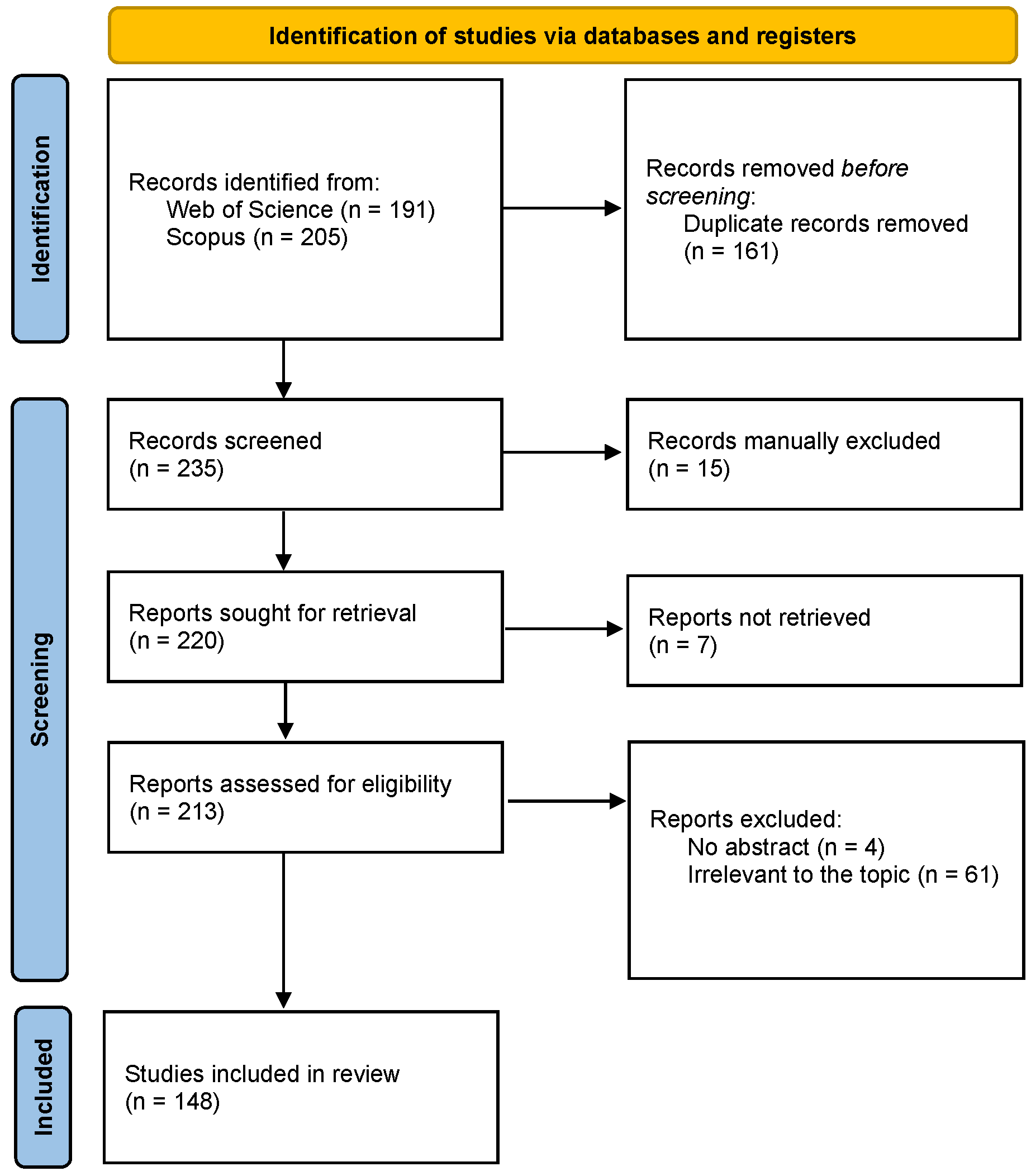
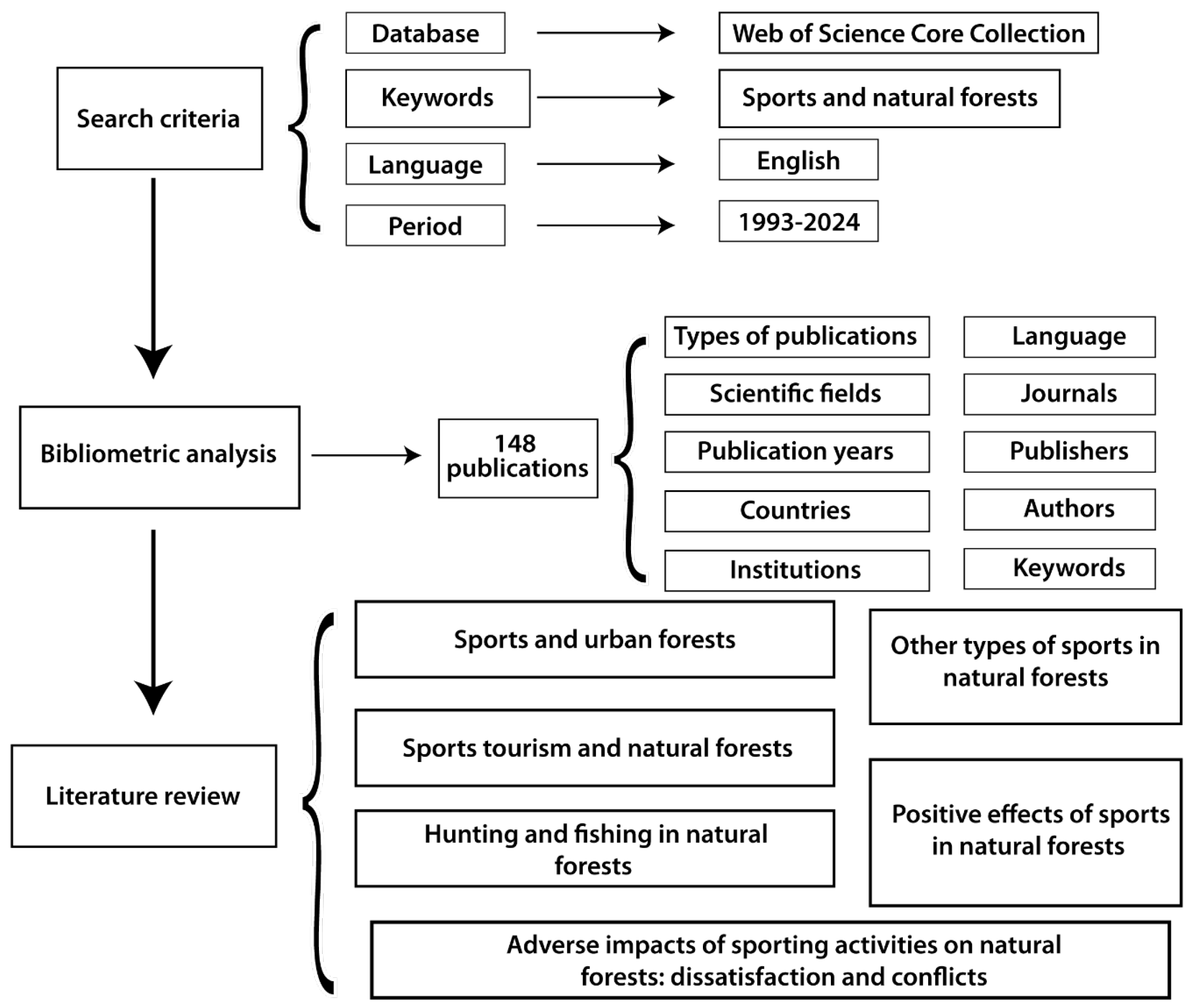
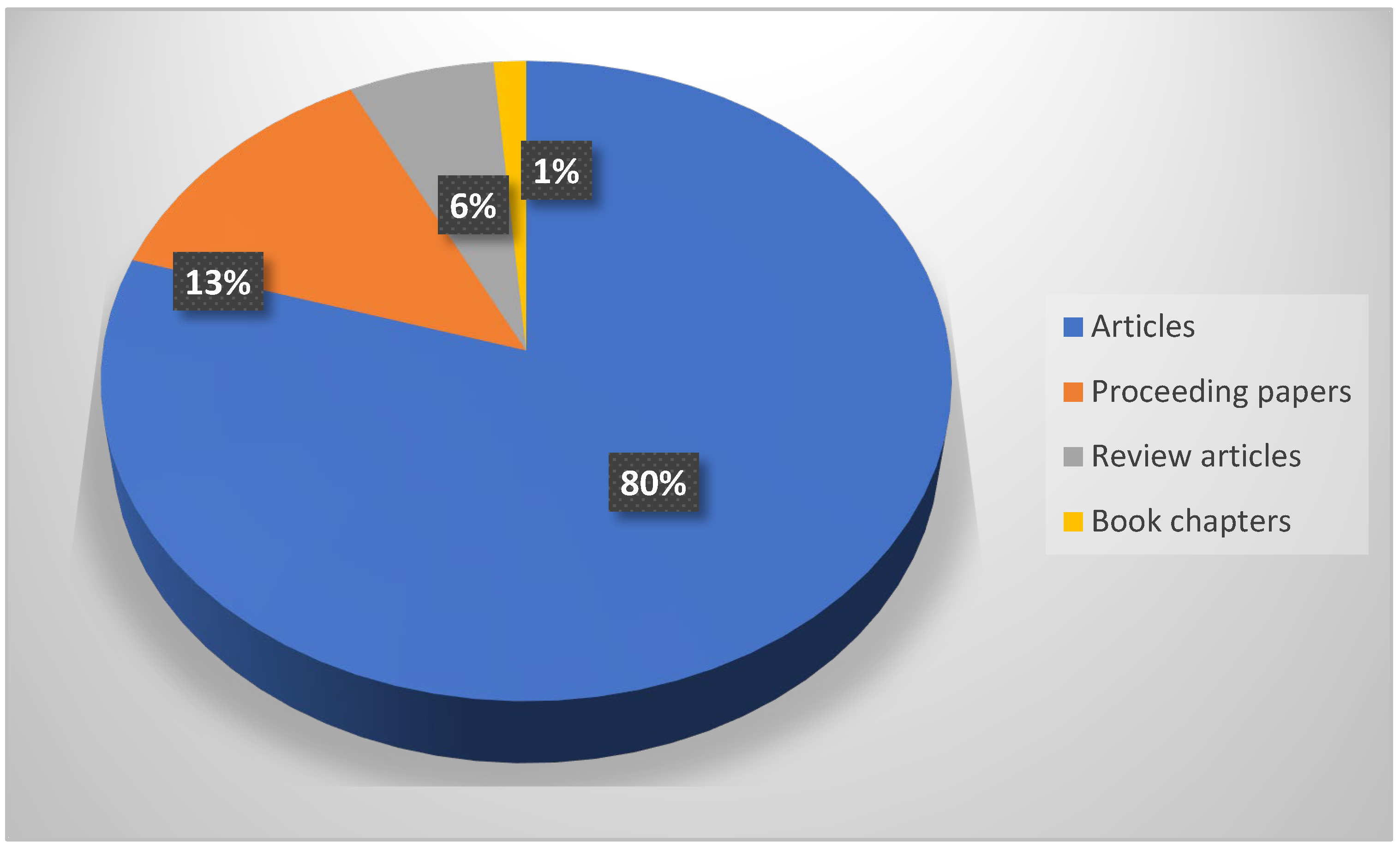
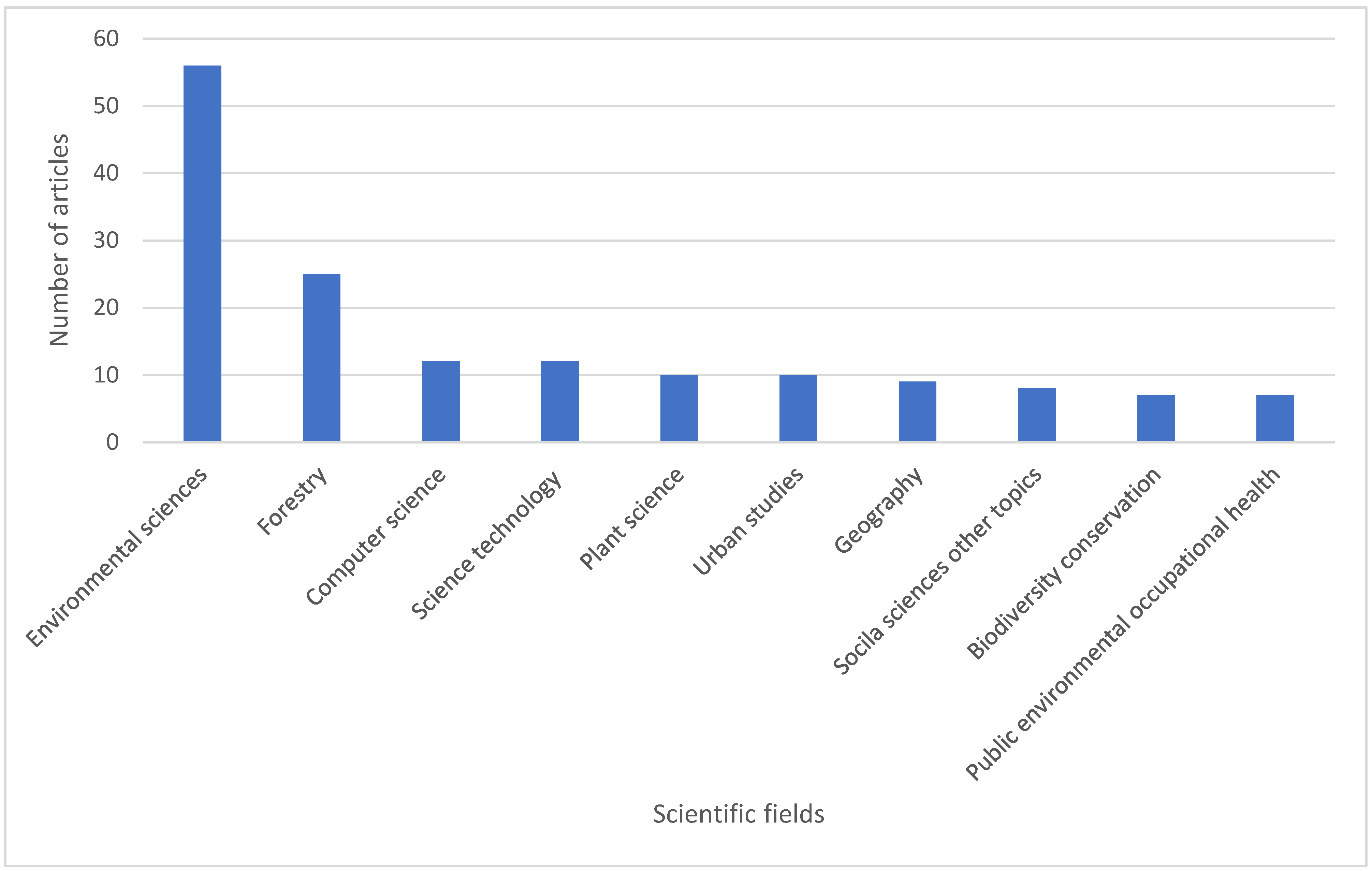
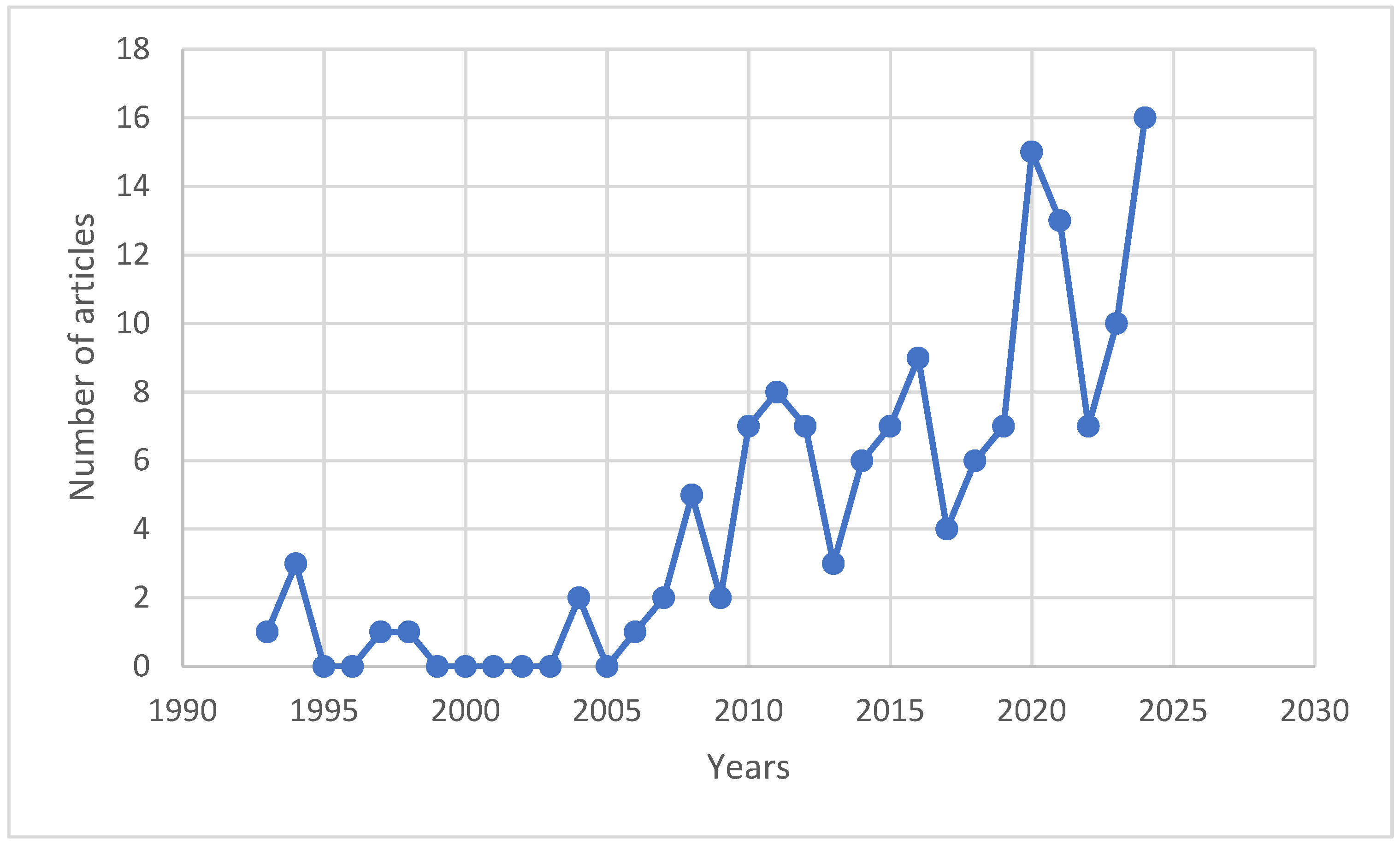
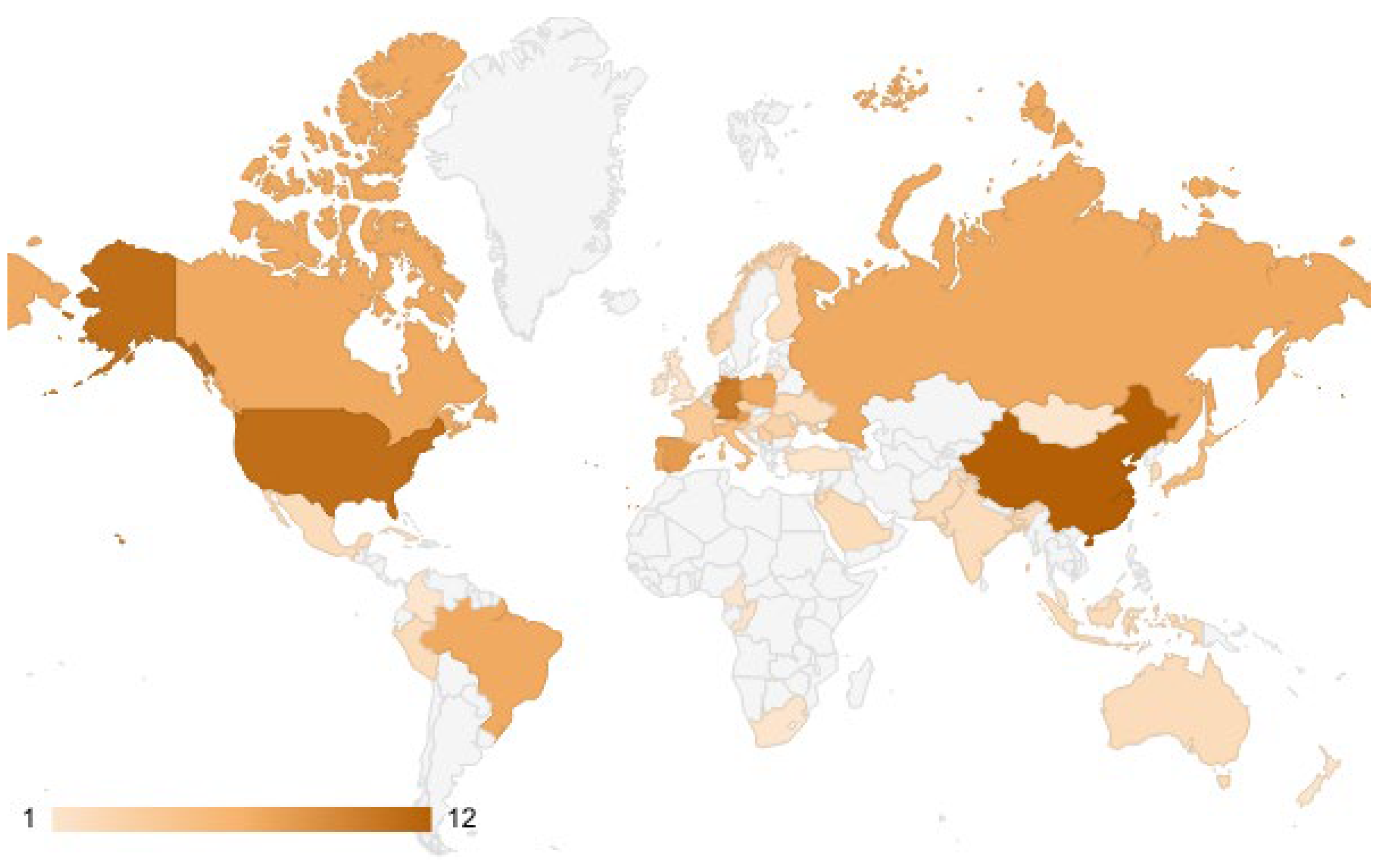
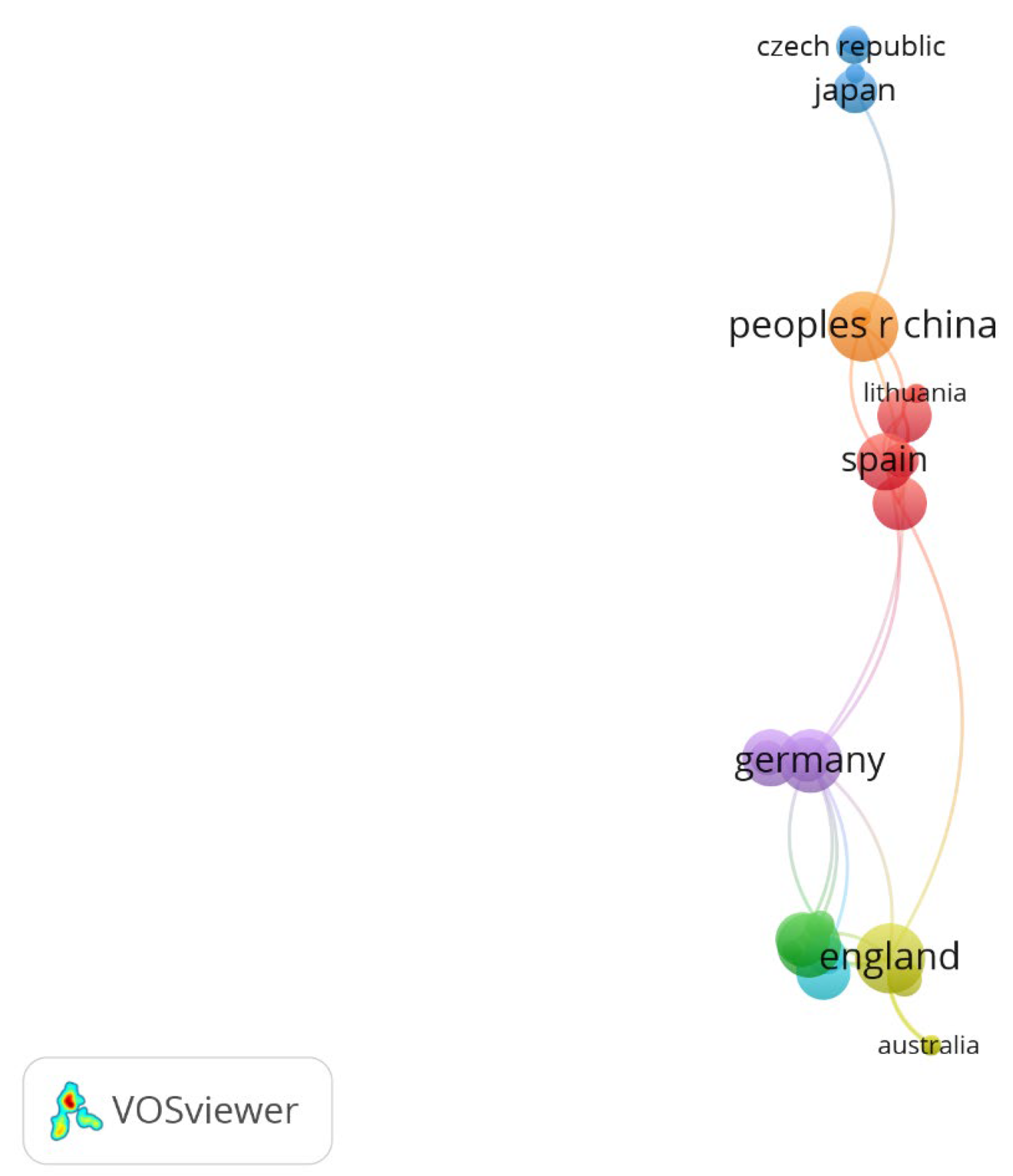

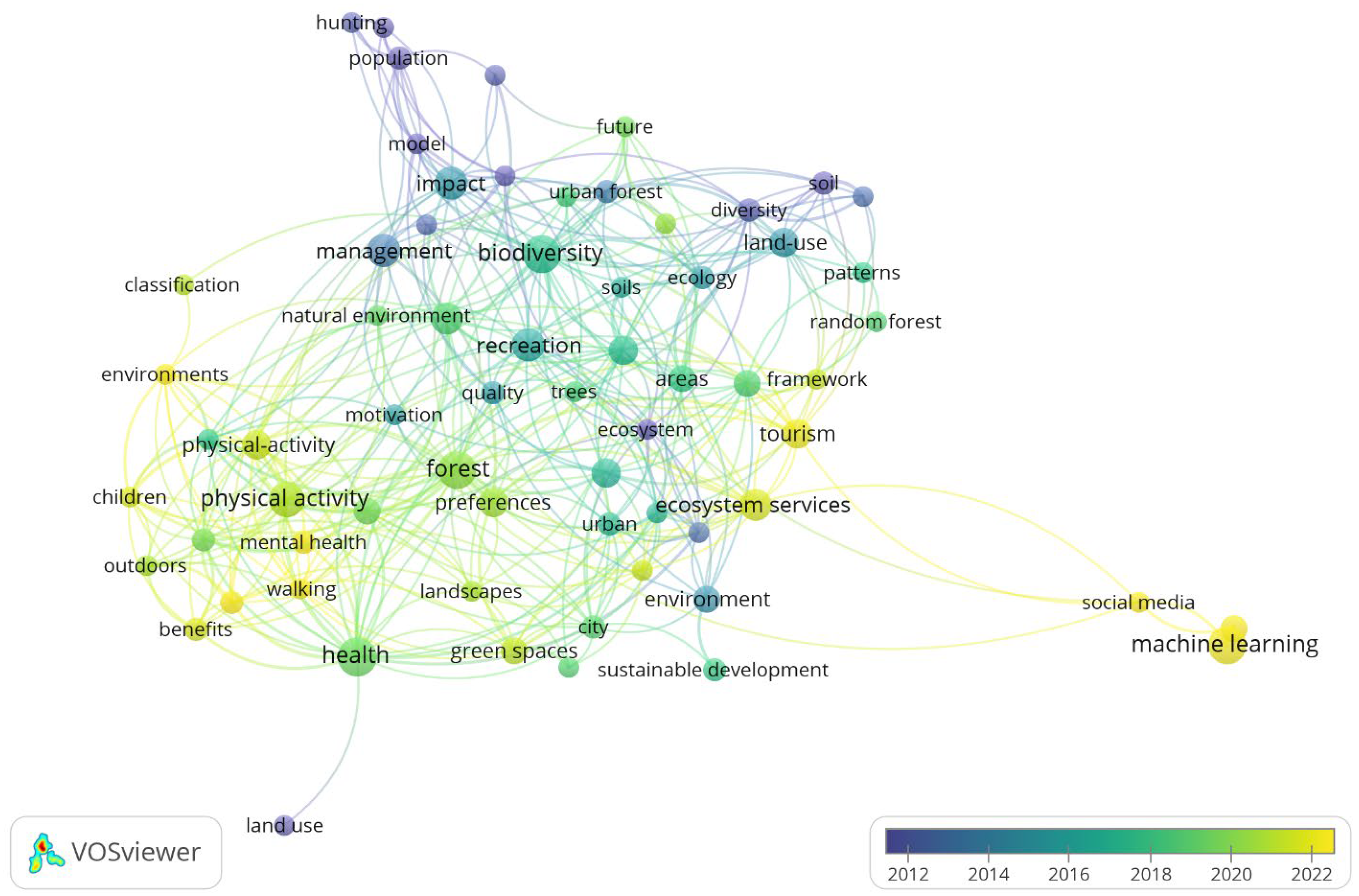
| Cur. no. | Country | Documents | Citations | Total Link Strength |
|---|---|---|---|---|
| 1 | England | 12 | 232 | 11 |
| 2 | Germany | 10 | 307 | 10 |
| 3 | Portugal | 7 | 22 | 7 |
| 4 | Scotland | 4 | 59 | 7 |
| 5 | Brazil | 7 | 27 | 6 |
| 6 | Spain | 8 | 61 | 6 |
| 7 | USA | 10 | 164 | 6 |
| 8 | Indonesia | 2 | 11 | 5 |
| 9 | China | 12 | 63 | 5 |
| 10 | Russia | 7 | 19 | 5 |
| 11 | Japan | 5 | 89 | 4 |
| 12 | Serbia | 3 | 14 | 4 |
| 13 | Austria | 8 | 168 | 3 |
| 14 | Canada | 7 | 197 | 1 |
| 15 | Italy | 5 | 168 | 1 |
| 16 | Poland | 7 | 23 | 0 |
| Cur. no. | Journal | Documents | Citations | Total Link Strength |
|---|---|---|---|---|
| 1 | Urban forestry and urban greening | 8 | 308 | 4 |
| 2 | International journal of environmental research and public health | 3 | 18 | 1 |
| 3 | Sylwan | 2 | 1 | 1 |
| 4 | American journal of health promotion | 1 | 2 | 1 |
| 5 | International journal of advanced computer science and applications | 1 | 31 | 1 |
| 6 | Sustainability | 6 | 27 | 0 |
| 7 | Forests | 6 | 5 | 0 |
| 8 | Forest ecology and management | 4 | 175 | 0 |
| 9 | Biodiversity and conservation | 3 | 92 | 0 |
| 10 | Agroforestry systems | 1 | 75 | 0 |
| 11 | American journal of lifestyle medicine | 1 | 58 | 0 |
| 12 | Applied sciences | 1 | 11 | 0 |
| 13 | Ecosystem services | 1 | 30 | 0 |
| Cur. no. | Keyword | Occurences | Total Link Strength |
|---|---|---|---|
| 1 | forest | 10 | 27 |
| 2 | health | 11 | 26 |
| 3 | physical activity | 9 | 24 |
| 4 | biodiversity | 10 | 23 |
| 5 | natural environments | 4 | 16 |
| 6 | tourism | 6 | 15 |
| 7 | ecosystem services | 7 | 14 |
| 8 | restoration | 5 | 14 |
| 9 | areas | 5 | 13 |
| 10 | green space | 4 | 13 |
| 11 | recreation | 8 | 13 |
| 12 | vegetation | 6 | 13 |
| 13 | impact | 8 | 12 |
| 14 | preferences | 6 | 12 |
| 15 | land-use | 6 | 11 |
| Crt. no. | Sports | Country | Authors |
|---|---|---|---|
| 1 | Ball sports | Switzerland | Hansmann et al., 2007 [80] |
| 2 | Bat and racket sports (e.g., table tennis, badminton) | England | O’Brien and Forster, 2020 [10] |
| 3 | Cycling | England | O’Brien and Forster, 2020 [10] |
| 4 | Climbing | Austria | Pröbstl-Haider et al., 2021 [81] |
| 5 | Cross-country races | Poland | Konieczny et al., 2020 [82] |
| 6 | Fitness (family fitness, boot camp, endurance) | USA; England; Austria | Cohen et al., 2012; O’Brien and Forster, 2020; Jungwirth et al., 2021 [10,58,83] |
| 7 | Hiking | France; China; England; Spain; Israel | Lepille, 2024; Zhang et al., 2024; O’Brien and Forster, 2020; Vidal-González and Vidal-Matzanke, 2020; Koniak et al., 2011 [10,15,20,84,85] |
| 8 | Horse riding | Poland | Konieczny et al., 2020 [82] |
| 9 | Jogging | Switzerland; Germany | Hansmann et al., 2007; Baumeister et al., 2020 [44,80] |
| 10 | Kayaking | China | Zhang et al., 2024 [84] |
| 11 | Mountain biking | France; Switzerland; Germany; England; | Lepille, 2024; Hansmann et al., 2007; Baumeister et al., 2020; King ang Church, 2015 [20,44,80,86] |
| 12 | Mountain trail running races | Spain | Vidal-González and Vidal-Matzanke, 2020 [15] |
| 13 | Motor sports | Portugal | Queirós, 2012 [87] |
| 14 | Orienteering | England; Poland; Australia | O’Brien and Forster, 2020; Mazurek-Kusiak and Soroka, 2021; Omodei and McLennan, 1994 [10,63,88] |
| 15 | Running | China; England | Zhang et al., 2024 [84] |
| 16 | Skying | Turkey | Aydınözü et al., 2011 [89] |
| 17 | Water sports (swimming, canoeing, fishing, boat ride) | Brazil | Nabout et al., 2022 [90] |
Disclaimer/Publisher’s Note: The statements, opinions and data contained in all publications are solely those of the individual author(s) and contributor(s) and not of MDPI and/or the editor(s). MDPI and/or the editor(s) disclaim responsibility for any injury to people or property resulting from any ideas, methods, instructions or products referred to in the content. |
© 2025 by the authors. Licensee MDPI, Basel, Switzerland. This article is an open access article distributed under the terms and conditions of the Creative Commons Attribution (CC BY) license (https://creativecommons.org/licenses/by/4.0/).
Share and Cite
Bratu, I.; Dinca, L.; Schiteanu, I.; Mocanu, G.; Murariu, G.; Stanciu, M.; Zhiyanski, M. Sports in Natural Forests: A Systematic Review of Environmental Impact and Compatibility for Readability. Sports 2025, 13, 250. https://doi.org/10.3390/sports13080250
Bratu I, Dinca L, Schiteanu I, Mocanu G, Murariu G, Stanciu M, Zhiyanski M. Sports in Natural Forests: A Systematic Review of Environmental Impact and Compatibility for Readability. Sports. 2025; 13(8):250. https://doi.org/10.3390/sports13080250
Chicago/Turabian StyleBratu, Iulian, Lucian Dinca, Ionut Schiteanu, George Mocanu, Gabriel Murariu, Mirela Stanciu, and Miglena Zhiyanski. 2025. "Sports in Natural Forests: A Systematic Review of Environmental Impact and Compatibility for Readability" Sports 13, no. 8: 250. https://doi.org/10.3390/sports13080250
APA StyleBratu, I., Dinca, L., Schiteanu, I., Mocanu, G., Murariu, G., Stanciu, M., & Zhiyanski, M. (2025). Sports in Natural Forests: A Systematic Review of Environmental Impact and Compatibility for Readability. Sports, 13(8), 250. https://doi.org/10.3390/sports13080250









